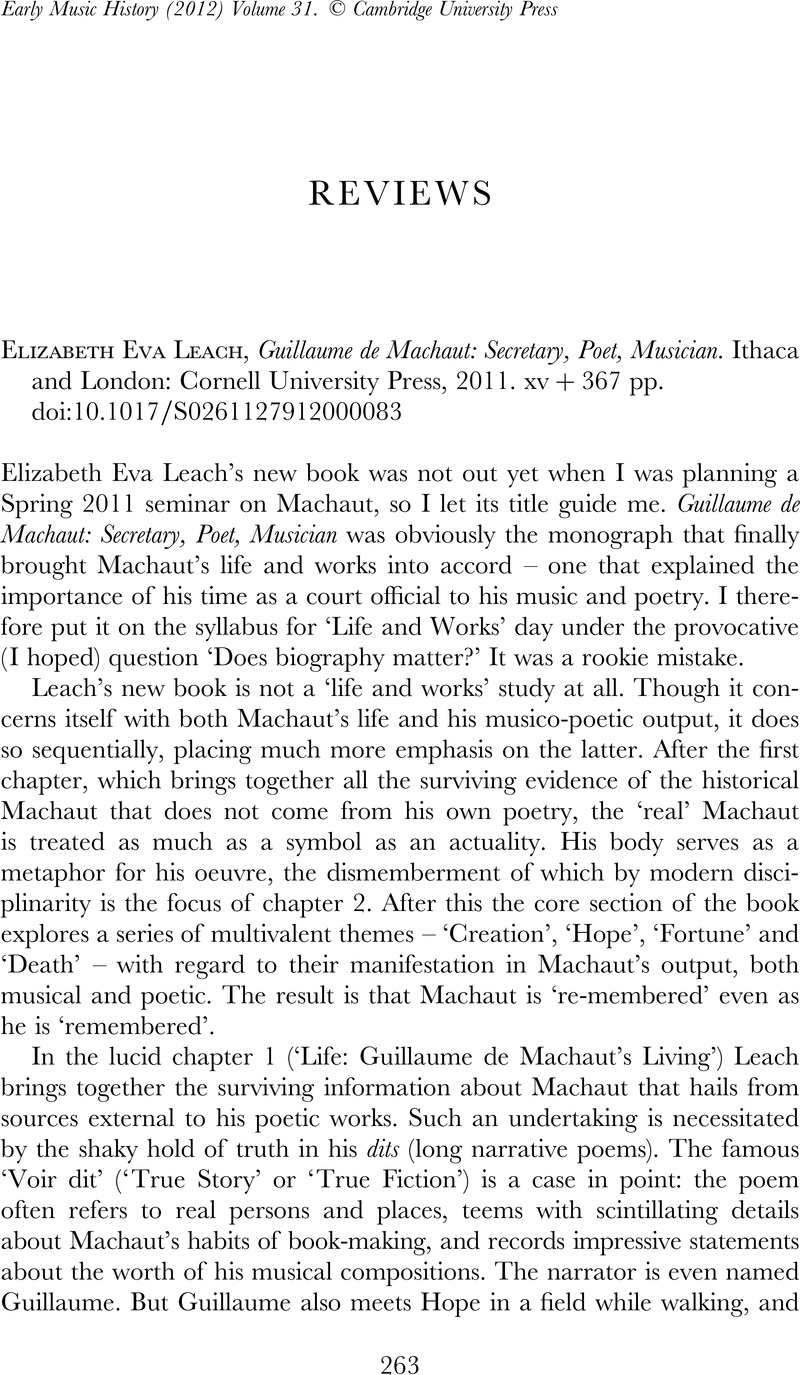Published online by Cambridge University Press: 08 August 2012

1 The former dit is a chronicle of the Cypriot king Pierre de Lusignan's crusade to Alexandria in 1365, while the Jugement dou roy de Navarre begins with what purports to be an eyewitness description of the Black Death. An interest in historical figures also led to some scholarly engagement with the Voir dit, and especially its heroine, then believed to represent Agnes of Navarre (pp. 37–8).
2 ‘Lawrence Earp's Guillaume de Machaut: A Guide to Research of 1995 provides detailed descriptions of the Machaut manuscripts with extensive bibliography. This will serve as the reference foundation for my dissertation’; Dominic Leo, ‘Authorial Presence in the Illuminated Machaut Manuscripts’ (Ph.D. diss., New York University, 2005), p. xvi.
3 Huot, Sylvia, From Song to Book: The Poetics of Writing in Old French Lyric and Lyrical Narrative Poetry (Ithaca, 1987)Google Scholar; Butterfield, Ardis, Poetry and Music in Medieval France: From Jean Renart to Guillaume de Machaut (Cambridge, 2002)Google Scholar; McGrady, Deborah, Controlling Readers: Guillaume de Machaut and his Late Medieval Audience (Toronto, 2006)Google Scholar.
4 The prologue images can be viewed in colour on Gallica: Love visits Machaut on fol. Dr <http://gallica.bnf.fr/ark:/12148/btv1b84490444/f15> and Nature on fol. Er <http://gallica.bnf.fr/ark:/12148/btv1b84490444/f17>.
5 See Leo, ‘Authorial Presence’, pp. 219–36.
6 See Machaut, , The Fountain of Love [La Fonteinne Amoureuse] and Two Other Love Vision Poems, trans. Palmer, R. Barton (New York, 1993), ll. 157–98 on pp. 10–13Google Scholar.
7 This couplet first appears in the Remede de Fortune (ll. 407–8) and is reused in letter 8 of the Voir dit; see Leach's discussion on p. 102, esp. n. 62.
8 The only part of the analysis with which one might take issue is the assertion that the ballade's rhythmic profile is intentionally a ‘patchwork of highly characteristic Machauldian melodic gestures’ (p. 117). These ‘musical quotations are snippets from Machaut's own songs – short, characteristic, but nonspecific rhythmic-motivic figure (sic) that can be found in a host of other Machaut works with the same mensural organization’ (p. 118, emphasis added). It seems problematic to argue that a rhythmic figure is both typical of a certain mensuration and a quotation.
9 Huot, , ‘Guillaume de Machaut and the Consolation of Poetry’, Modern Philology, 100 (2002), pp. 169–95CrossRefGoogle Scholar.
10 Despite the analogy to the shift from Ars antiqua to Ars nova, Leach makes clear that the move from Desire and despair to Hope and joy is not a chronological progression – after all, Fortune wins out over Hope in the late Voir dit. Rather, it is a shift staged by manuscript A and intended for the reader (p. 168).
11 It is mislabelled as ‘B21’ at the top of Figure 5.1.
12 Huot, , ‘Reading across Genres: Froissart's Joli buisson de Jonece and Machaut's Motets’, French Studies, 57 (2003), pp. 1–10CrossRefGoogle Scholar. It is equally possible to argue, using this passage, that the motet belongs entirely to the courtly world since its sound stops precisely when the singer is shoved and awoken from his pleasant allegorical dream. For this reading see Zayaruznaya, ‘Form and Idea in the Ars nova Motet’ (Ph.D. diss., Harvard University, 2010), pp. 12–13.
13 Trans. Palmer in Machaut, The Fountain of Love and Two Other Love Vision Poems, pp. 13–17. Punctuation modified.
14 Leach, , Sung Birds: Music, Nature, and Poetry in the Later Middle Ages (Ithaca, 2007), p. 108Google Scholar.
15 The third stanza adds Souvenirs (Memory) to the roster.
16 For an illuminating analysis of this ballade see Leach, , ‘Singing More about Singing Less: Machaut's Pour ce que tous (B12)’, in Leach, Elizabeth Eva (ed.), Machaut's Music: New Interpretations (Woodbridge, 2003), pp. 111–24Google Scholar.
17 See Machaut, , Poésies lyriques, ed. Shishmarev, Vladimir Fedorovich, 2 vols (Paris, 1909), i, pp. 171–6Google Scholar.
18 Indeed, when Toute Belle sends this ballade to Guillaume in the Voir dit, where it is repurposed, its function is precisely to cheer him up. See Leach's discussion on this point on p. 257.
19 See Earp, , Guillaume de Machaut: A Guide to Research (London, 1995), p. 244Google Scholar.
20 ‘Sylvia Huot sees this as a more radical revision of Boethius than Machaut had presented in the Remede’, p. 170.
21 See pp. 141, 159, 175, 191, 290. Perhaps because her name does not appear in the main text on these pages, they are not included in the index under Huot's name.
22 This analysis is also published in Leach, , ‘Music and Verbal Meaning: Machaut's Polytextual Songs’, Speculum, 85 (2010), pp. 567–91, at 573–87Google Scholar.
23 Fuller, Sarah, ‘A Phantom Treatise of the Fourteenth Century? The Ars Nova’, Journal of Musicology, 4 (1985), pp. 23–50CrossRefGoogle Scholar.
24 ‘Related Motets from Fourteenth-Century France’, Proceedings of the Royal Musical Association, 109 (1982), pp. 1–22CrossRefGoogle Scholar.
25 See Michael Scott Cuthbert, ‘Trecento Fragments and Polyphony beyond the Codex’ (Ph.D. diss., Harvard University, 2006), p. 117, an argument which he is developing further in his forthcoming book, Credo Scabioso: Italian Sacred Music in the Age of Plague and Schism.